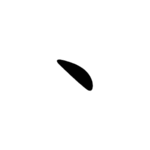Radical 3
| 丶 | ||
|---|---|---|
| ||
| 丶 (U+4E36) "dot" | ||
| Pronunciations | ||
| Pinyin: | zhǔ | |
| Bopomofo: | ㄓㄨˋ | |
| Wade–Giles: | chu3 | |
| Cantonese Yale: | jyu2 | |
| Jyutping: | zyu2 | |
| Pe̍h-ōe-jī: | tú | |
| Japanese Kana: | チュ chu てん ten | |
| Sino-Korean: | 주 ju | |
| Names | ||
| Japanese name(s): | 点 ten | |
| Hangul: | 점 jeom | |
| Stroke order animation | ||
 | ||
Radical 3 meaning "to indicate an end"[1] is one of six of the 214 Kangxi radicals that are composed of only one stroke.
In the Kangxi Dictionary, there are only 10 characters (out of 49,030) to be found under this radical.
Characters with Radical 3

| Strokes | Characters & Pinyin & Meanings |
|---|---|
| 0 | 丶 zhǔ "dot" |
| 1 | 丷 (Korean kwukyel note) |
| 2 | 丸 wán "pellet" |
| 3 | 丹 dān "vermillion", 为 wéi "to do, to be" |
| 4 | 主 zhǔ "owner, master", 丼 jǐng "bowl" |
| 7 | 丽 lì "pretty, lovely" |
| 8 | 举 jǔ "raise, recommend" |
References
- ^ Shuowen Jiezi: “丶,有所絶止,丶而識之也”. "Where there is an end, 丶 is used to recognize it." This refers to the practice of using 丶 as a judou punctation mark.
Literature
- Fazzioli, Edoardo (1987). Chinese calligraphy : from pictograph to ideogram : the history of 214 essential Chinese/Japanese characters. calligraphy by Rebecca Hon Ko. New York: Abbeville Press. ISBN 0-89659-774-1.
- Leyi, Li (1993). Tracing the Roots of Chinese Characters: 500 Cases. Beijing. ISBN 978-7-5619-0204-2.
{{cite book}}: CS1 maint: location missing publisher (link)
External links
Wikimedia Commons has media related to Radical 003.
